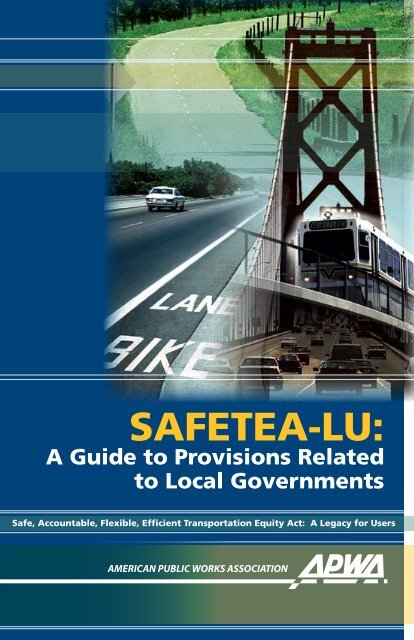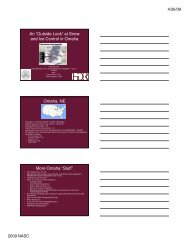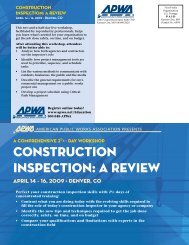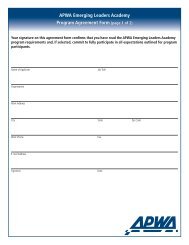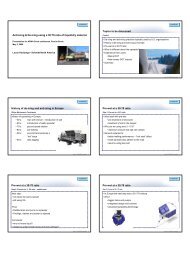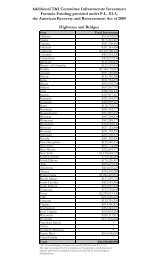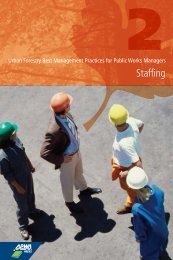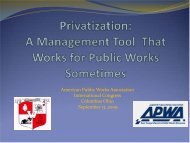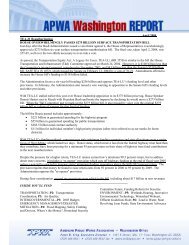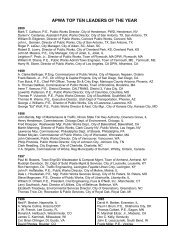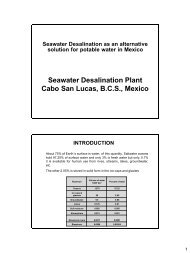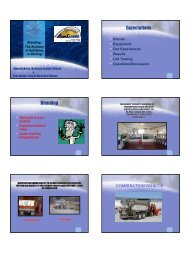SAFETEA-LU: - American Public Works Association
SAFETEA-LU: - American Public Works Association
SAFETEA-LU: - American Public Works Association
You also want an ePaper? Increase the reach of your titles
YUMPU automatically turns print PDFs into web optimized ePapers that Google loves.
<strong>SAFETEA</strong>-<strong>LU</strong>:A Guide to Provisions Relatedto Local GovernmentsSafe, Accountable, Flexible, Efficient Transportation Equity Act: A Legacy for Users
On August 10, 2005, President George W. Bush signed into law the sixyear,$286.4 billion Safe, Accountable, Flexible, Efficient TransportationEquity Act: A Legacy for Users (<strong>SAFETEA</strong>-<strong>LU</strong>), the largest investment insurface transportation in the nation’s history.For the years 2005 to 2009, <strong>SAFETEA</strong>-<strong>LU</strong> (<strong>Public</strong> Law 109-59) provides$193 billion for highways and bridges, $45.2 billion for publictransportation and $5.8 billion for motor carrier and transportation safetyprograms. Highway funding will grow from $34.4 billion in 2005 to$41.2 billion in 2009, and transit funding will rise from $7.6 billion in2005 to $10.3 billion in 2009. The law expires on September 30, 2009.<strong>SAFETEA</strong>-<strong>LU</strong> reflects many key priorities advocated by APWA. Itincreases investment in highway, transit and safety programs and retainsthe basic goals and structure of the Transportation Equity Act for the21st Century (TEA-21), with its enhanced role for local decision-makingand its important emphasis on flexibility, intermodal goals and onaddressing local and regional needs. In addition, <strong>SAFETEA</strong>-<strong>LU</strong> elevatesthe importance of safety by creating a new core safety program; continuesguaranteed funding for transportation programs; and streamlines theenvironmental review and project delivery process.<strong>SAFETEA</strong>-<strong>LU</strong>: A Guide to Provisions Related to Local GovernmentsAPWA was able to achieve these important successes through thededication, advocacy and leadership of APWA’s TEA-21 ReauthorizationTask Force – Don LaBelle, Chair; Marshall Elizer, Jerry Fay, Bruce Florquist,John German, John Herzke, Ed Laudenslager, Mary Meloy, MiltonMitchell, John Okamoto, Richard Storm and Lance Wilber – and ourmembers, chapters, the Transportation Technical and Government AffairsCommittees and the Board of Directors.This guide highlights select highway, transit and safety programs whichcontain provisions of interest to local officials.More information about <strong>SAFETEA</strong>-<strong>LU</strong> is available online from the U.S.Department of Transportation’s Federal Highway Administration, www.fhwa.dot.gov, Federal Transit Administration, www.fta.dot.gov, and fromAPWA, www.apwa.net/advocacy.Bob FreudenthalAPWA President, 2005-06
Safe, Accountable, Flexible, Efficient Transportation Equity Act: A Legacy for UsersTable of ContentsSAFTEA-<strong>LU</strong> Total Program Funding (table)..............................................................3<strong>SAFETEA</strong>-<strong>LU</strong> Highway Programs..............................................................................3Appalachian Development Highway System Program (ADHS) ...............................................3Congestion Mitigation and Air Quality Improvement Program (CMAQ) .................................3Delta Region Transportation Development Program...............................................................3Environmental Review Process.............................................................................................4Equity Bonus Program..........................................................................................................4High Priority Projects............................................................................................................5Highway Bridge Program......................................................................................................5Highway Safety Improvement Program (HSIP) ......................................................................5Metropolitan Planning.........................................................................................................6National Highway System Program (NHS) ............................................................................6National Historic Covered Bridge Preservation......................................................................6Real-Time System Management Information Program...........................................................7Safe Routes to School Program............................................................................................7Statewide Planning..............................................................................................................8Stewardship and Oversight Program.....................................................................................8Surface Transportation-Environmental Cooperative Research Program (STEP).........................8Surface Transportation Program (STP)...................................................................................8Training and Education Program...........................................................................................9Transportation, Community and System Preservation Program (TCSP)....................................9Transportation Enhancement Program (TE).........................................................................10Transportation Infrastructure Finance and Innovation Act (TIFIA).........................................10Transportation Systems Management and Operation...........................................................11Truck Parking Facilities.......................................................................................................11Work Zone Safety Provisions..............................................................................................11SAFTEA-<strong>LU</strong> Highway Program Funding (table)......................................................12<strong>SAFETEA</strong>-<strong>LU</strong> Transit Programs...............................................................................13Alternative Transportation in Parks and <strong>Public</strong> Lands...........................................................13Bus and Bus Facilities Grants..............................................................................................13Capital Investment Grants “New Starts” and “Small Starts” ..............................................13Clean Fuels Grant Program.................................................................................................13Job Access and Reverse Commute Program........................................................................13Metropolitan and Statewide Planning Programs.................................................................14New Freedom Program......................................................................................................14Other Than Urbanized Area Formula Program.....................................................................14Safety and Security Provisions............................................................................................14Special Needs for Elderly Individuals and Individuals with Disabilities .................................14Urbanized Area Formula Grants..........................................................................................15SAFTEA-<strong>LU</strong> Transit Program Funding (table).........................................................15Additional <strong>SAFETEA</strong>-<strong>LU</strong> Resources........................................................................16Glossary of Terms..................................................................................................16APWA 2005-2006 Board of Directors....................................................................20
<strong>SAFETEA</strong>-<strong>LU</strong> Funding (In Billions of Dollars)Five-Year Funding Levels2005-2009 2004-2009Highways $193.0 $227.4Transit $45.2 $52.6Safety $5.8 $6.5Total $244.1 $286.4<strong>SAFETEA</strong>-<strong>LU</strong> Highway ProgramsAppalachian DevelopmentHighway System Program(ADHS)The ADHS program continuesfunding for the construction of theAppalachian corridor highwaysin 13 states. The purpose of thisprogram is to promote economicdevelopment and to establish astate-federal framework to meetthe needs of the region. Funds willbe available to construct highwaysand local access roads undersection 14501 of title 40, UnitedStates Code (USC). <strong>SAFETEA</strong>-<strong>LU</strong>Section(s): 1101(a)(7), 1116Congestion Mitigation andAir Quality ImprovementProgram (CMAQ)CMAQ provides funding forprojects and programs in air qualitynon-attainment and maintenanceareas. Eligible projects includethose that improve transportationsystems management andoperations that mitigate congestionand improve air quality, as well asthose that involve the purchaseof integrated, interoperableemergency communicationsequipment, among other things.States and metropolitan planningSix-Year Funding Levelsorganizations will give priorityin distributing funds for projectsand programs to diesel retrofitsand other cost-effective emissionreduction activities, and costeffectivecongestion mitigationactivities that provide air qualitybenefits. <strong>SAFETEA</strong>-<strong>LU</strong> Section(s):1101(a)(5), 1103(d), 1808Delta Region TransportationDevelopment ProgramMetropolitan planningorganizations are eligible recipientsof funds under this programdesigned to support and encouragemulti-state transportation planningand corridor development,provide for transportationproject development, facilitatetransportation decision-makingand support transportationconstruction in the eight statescomprising the Delta Region(Alabama, Arkansas, Illinois,Kentucky, Louisiana, Mississippi,Missouri and Tennessee). <strong>SAFETEA</strong>-<strong>LU</strong> Section(s): 1308, 1923<strong>SAFETEA</strong>-<strong>LU</strong>: A Guide to Provisions Related to Local Governments
Safe, Accountable, Flexible, Efficient Transportation Equity Act: A Legacy for UsersEnvironmental ReviewProcess<strong>SAFETEA</strong>-<strong>LU</strong> incorporateschanges aimed at improving andstreamlining the environmentalprocess for transportation projects.These changes come with someadditional steps and requirementsfor transportation agencies.A new environmental reviewprocess is established for highways,transit and multimodal projects.The process applies to new projectsadvanced with environmentalimpact statements and can beapplied, if the U.S. Departmentof Transportation (DOT) elects,to projects advanced with otherenvironmental documents. A newcategory of “participating agencies”is added to allow more state, localand tribal agencies a formal roleand rights in the environmentalprocess. After providing anopportunity for public andinteragency involvement, DOTwill define the project’s purposeand need, and establish a planfor coordinating public andagency participation. As early aspracticable in the process, DOTis to provide an opportunityfor a range of alternatives to beconsidered for a project. If anyissue that could delay the processcannot be resolved within 30 days,DOT must notify Congress. A180-day statute of limitations forlawsuits challenging federal agencyapprovals is provided, but it willrequire a new step of publishingenvironmental decisions in theFederal Register.Additional changes include: stateassumption of responsibilities forcategorical exclusions; the creationof a five-state pilot program(Alaska, Ohio, Oklahoma, Texasand California) to assume DOTenvironmental responsibilitiesunder the National EnvironmentalPolicy Act (NEPA) and otherenvironmental laws (excluding theClean Air Act and transportationplanning requirements); andstreamlining section 4(f) of theDepartment of Transportation Act.<strong>SAFETEA</strong>-<strong>LU</strong> Section(s): 6002-6005,6007, 6009, 6010Equity Bonus ProgramThe Equity Bonus programprovides funding to states basedon equity considerations. Theseinclude a minimum rate of returnon contributions to the HighwayAccount of the Highway TrustFund, and a minimum increaserelative to the average dollaramount of apportionmentsunder TEA-21. Selected statesare guaranteed a share ofapportionments and High PriorityProjects (see next section) not lessthan the state’s average annual
share under TEA-21. This programreplaces TEA-21’s MinimumGuarantee program. <strong>SAFETEA</strong>-<strong>LU</strong>Section(s): 1104, 1102High Priority ProjectsThe High Priority Projects programprovides designated funding forspecific projects identified in<strong>SAFETEA</strong>-<strong>LU</strong>. A total of 5,091projects are identified, each witha specified amount of fundingover the five years of <strong>SAFETEA</strong>-<strong>LU</strong>. <strong>SAFETEA</strong>-<strong>LU</strong> Section(s):1101(a)(16), 1102, 1701, 1702,1913, 1935, 1936Highway Bridge ProgramThe Highway Bridge programprovides funding to enable statesto improve the condition oftheir highway bridges throughreplacement, rehabilitationand systematic preventivemaintenance. A set-aside of notless than 15 percent of the amountapportioned to each state in eachfiscal year 2005–2009 will be usedfor bridge projects that are not on afederal-aid highway.Eligible activities are expanded toinclude systematic preventativemaintenance on federal-aid andnon-federal-aid highway systems.States may carry out projectsfor the installation of scourcountermeasures or systematicpreventative maintenancewithout regard to whether thebridge is eligible for rehabilitationor replacement. <strong>SAFETEA</strong>-<strong>LU</strong>Section(s): 1101(a)(3), 1114Highway Safety ImprovementProgram (HSIP)The Highway Safety ImprovementProgram authorizes a new corefederal-aid funding programbeginning in fiscal year 2006 toachieve a significant reductionin traffic fatalities and seriousinjuries on all public roads. Eachstate’s apportionment of HSIPfunds is subject to a set-aside forconstruction and operationalimprovements on high-risk ruralroads. High-risk rural roads areroadways functionally classifiedas rural major or minor collectorsor rural local roads with a fatalityand incapacitating injury crashrate above the statewide averagefor those functional classes ofroadways; or likely to experiencean increase in traffic volumethat leads to a crash rate inexcess of the average state-widerate. The set-aside will total $90million annually and be appliedproportionally to the states’ HSIPapportionments. <strong>SAFETEA</strong>-<strong>LU</strong>Section(s): 1101(a)(7), 1116Before apportioning HSIP funds,$220 million is set aside forthe Railway-Highway Crossingprogram under 23 USC 130. ByOctober 1, 2007, each state musthave a Strategic Highway SafetyPlan (SHSP) that identifies andanalyzes safety problems andopportunities in order to use HSIPfunds for new eligible activitiesunder 23 USC 148. Funds maybe used for projects on any publicroad or publicly owned bicycleand pedestrian pathway or trail.States without an SHSP in fiscalyear 2006 or any year thereafter<strong>SAFETEA</strong>-<strong>LU</strong>: A Guide to Provisions Related to Local Governments
Safe, Accountable, Flexible, Efficient Transportation Equity Act: A Legacy for Userswill receive safety apportionmentsthat may be used only for projectseligible under 23 USC 130 and 152(railway-highway crossings andhazard elimination) as in effectprior to enactment of <strong>SAFETEA</strong>-<strong>LU</strong>. If a state does not have aplan in place by October 1, 2007,subsequent HSIP apportionmentsare frozen at the 2007 level andmay only be used to fund projectseligible under sections 130 and 152as in effect prior to enactment of<strong>SAFETEA</strong>-<strong>LU</strong>. States without SHSPswill be ineligible to use up to 10percent of their HSIP funds forother safety projects under 23 USC.<strong>SAFETEA</strong>-<strong>LU</strong> Section(s): 1101(a)(6),1401Metropolitan PlanningThe metropolitan planningprocess establishes a cooperative,continuous and comprehensiveframework for makingtransportation investment decisionin metropolitan areas. Localofficials, in cooperation with thestate and transit operators, remainresponsible for determining thebest transportation investments tomeet metropolitan transportationneeds. Key modifications tometropolitan planning in <strong>SAFETEA</strong>-<strong>LU</strong> include: metropolitan planningorganizations will be encouragedto consult or coordinate withplanning officials responsible forother types of planning activitiesaffected by transportation, and themetropolitan planning process isto promote consistency betweentransportation improvements andstate and local planned growth andeconomic development patterns.<strong>SAFETEA</strong>-<strong>LU</strong> Section(s): 1107, 6001National Highway SystemProgram (NHS)The National Highway Systemprogram provides funding forimprovements to rural and urbanroads that are part of the NHS,including the Interstate System anddesignated connections to majorintermodal terminals. Undercertain circumstances, NHS fundsmay also be used to fund transitimprovements in NHS corridors.NHS eligibility is expanded toinclude the following activities:environmental restoration andpollution abatement, control ofterrestrial and aquatic noxiousweeds, and establishment of nativespecies. <strong>SAFETEA</strong>-<strong>LU</strong> Section(s):1101(a)(2), 1103, 6006National Historic CoveredBridge PreservationThe National Historic CoveredBridge Preservation programprovides for the rehabilitation,repair or preservation of coveredbridges that are listed or eligiblefor listing on the National Registerof Historic Places. Eligible usesof funds are the rehabilitation
or repair of a historic coveredbridge or the preservation ofsuch a bridge. The Secretary ofTransportation will make grantsbased on applications from statesthat demonstrate the need forassistance in carrying out oneor more eligible historic coveredbridge projects. <strong>SAFETEA</strong>-<strong>LU</strong>Section(s): 1804Real-Time SystemManagement InformationProgramThe Real-Time System ManagementInformation program provides thecapability to monitor, in real-time,the traffic and travel conditionsof the major highways of theUnited States and to share theinformation. As states and localgovernments develop or updateregional intelligent transportationsystem architectures as describedin 23 Code of Federal Regulations940.9, they shall explicitly addressreal-time highway and transitinformation needs and the systemsneeded to meet those needs.While there are no separate fundsauthorized for this program, statesmay use their National HighwaySystem, Congestion Mitigation andAir Quality Improvement program,and Surface TransportationProgram apportionments foractivities related to the planningand deployment of real-timemonitoring elements thatadvance the goals of this program.<strong>SAFETEA</strong>-<strong>LU</strong> Section(s): 1201Safe Routes to SchoolProgramThe purpose of the Safe Routes toSchool program is to enable andencourage children, includingthose with disabilities, to walk andbicycle to school, and to facilitatethe planning, development andimplementation of projects thatwill improve safety, and reducetraffic, fuel consumption and airpollution in the vicinity of schools.Funds are to be administered bystate departments of transportationto provide financial assistance tostate, local and regional agenciesthat demonstrate the ability tomeet the requirements of theprogram. For infrastructurerelatedprojects, eligible activitiesinclude the planning, design andconstruction of projects that willsubstantially improve the abilityof students to walk and bicycle toschool. Each state must set asidefrom its Safe Routes to Schoolapportionment not less than 10percent and not more than 30percent of the funds for noninfrastructure-relatedactivities toencourage walking and bicyclingto school. These include publicawareness campaigns and outreachto press and community leaders;traffic education and enforcement<strong>SAFETEA</strong>-<strong>LU</strong>: A Guide to Provisions Related to Local Governments
Safe, Accountable, Flexible, Efficient Transportation Equity Act: A Legacy for Usersin the vicinity of schools; studentsessions on bicycle and pedestriansafety, health and environment;and training, volunteers andmanagers of Safe routes to Schoolprograms. <strong>SAFETEA</strong>-<strong>LU</strong> Section(s):1101(a)(17), 1404Statewide PlanningThe statewide planning processestablishes a cooperative,continuous and comprehensiveframework for makingtransportation investmentdecisions throughout the state.Statewide planning is an eligibleactivity for additional fundingunder the Surface TransportationProgram and the National HighwaySystem program. Planning andprogramming shall continue tobe developed in consultationwith affected local officialsresponsible for transportation innon-metropolitan areas. A keymodification to this provisionwill promote consistency betweentransportation improvements andstate and local planned growth andeconomic development patterns.<strong>SAFETEA</strong>-<strong>LU</strong> Section(s): 6001of Transportation will periodicallyreview the monitoring of subrecipientsby the state. <strong>SAFETEA</strong>-<strong>LU</strong> Section(s): 1904Surface Transportation-Environmental CooperativeResearch Program (STEP)The STEP program establishesa surface transportationenvironmentalcooperative researchprogram to improve understandingof the complex relationshipbetween surface transportationand the environment. It mayinclude research to develop moreaccurate models for evaluatingtransportation control measuresand system designs for use by stateand local governments to meetenvironmental requirements.<strong>SAFETEA</strong>-<strong>LU</strong> Section(s): 5207Stewardship and OversightProgramThe Stewardship and Oversightprogram monitors the effectiveand efficient use of resources tobest meet the transportation needsof the nation with a specific focuson financial integrity and projectdelivery. Under the program,states will be responsible fordetermining that sub-recipients offederal funds have adequate projectdelivery systems and sufficientaccounting controls. The SecretarySurface TransportationProgram (STP)The Surface TransportationProgram provides flexible fundingthat may be used by states andlocalities for projects on anyfederal-aid highway, including theNational Highway System, bridge
projects on any public road, transitcapital projects, and intra-cityand intercity bus terminals andfacilities. The program continuesexisting STP eligibilities and addsthe following: advanced truck stopelectrification systems, projectsrelating to intersections withcertain qualifications,environmental restoration andpollution abatement and controlof terrestrial and aquatic noxiousweeds and establishment of nativespecies. The Safety set-aside iseliminated as the new HighwaySafety Improvement Programtakes over funding of the safetyprograms. The TransportationEnhancements’ (TE) set-asideis modified to be the greaterof 10 percent of the state’s STPapportionment or the dollaramount of the TE set-aside forthe state for 2005. <strong>SAFETEA</strong>-<strong>LU</strong>Section(s): 1101(a)(4), 1103(f),1113, 1603, 1960, 6006Training and EducationProgramThe Training and Educationprogram provides funding todevelop and administer educationand training programs to supportthose associated with surfacetransportation. A significantfeature of the program is the LocalTechnical Assistance Program,which continues to provideaccess to surface transportationtechnology to highway andtransportation agencies inurbanized and rural areas and tocontractors who perform workfor those agencies. <strong>SAFETEA</strong>-<strong>LU</strong>Section(s): 5101, 5204, 5505Transportation, Communityand System PreservationProgram (TCSP)The TCSP program is intended toaddress the relationships amongtransportation, communityand system preservation plansand practices, and identifyprivate sector-based initiativesto improve those relationships.Funds are to be allocated by theSecretary of Transportation tothe states, metropolitan planningorganizations and local and tribalgovernments. Funds may beused to carry out eligible projectsto integrate transportation,community and systempreservation plans and practices.The Secretary of Transportationwill make grants based onapplications from states, tribal,regional and local governments,with priority consideration givento applicants that have institutedcoordinated preservation ordevelopment plans that promote<strong>SAFETEA</strong>-<strong>LU</strong>: A Guide to Provisions Related to Local Governments
Safe, Accountable, Flexible, Efficient Transportation Equity Act: A Legacy for Userscost-effective investment andprivate sector strategies; haveinstituted other TCSP polices suchas those addressing high-growthareas, urban growth boundaries,“green corridors” programs thatprovide access to major highwaycorridors for controlled growthareas; address environmentalmitigation; and encourage privatesector involvement. <strong>SAFETEA</strong>-<strong>LU</strong>Section(s): 1117Transportation EnhancementProgram (TE)The purpose of the TransportationEnhancements program is tostrengthen the cultural, aestheticand environmental aspects of thenation’s intermodal transportationsystem. A state’s TE funding isderived from a set-aside from itsannual Surface TransportationProgram (STP) apportionment. For2005, the amount set aside for TEwill be 10 percent of the State’s STPapportionment (after application ofthe set-aside for the State Planningand Research program). After 2005,the TE set-aside will be 10 percentor the amount set aside for TE inthe state in 2005, whichever isgreater.removal of outdoor advertising.<strong>SAFETEA</strong>-<strong>LU</strong> Section(s): 1113, 1122,6003Transportation InfrastructureFinance and Innovation Act(TIFIA)The TIFIA program provides federalcredit assistance to nationallyor regionally significant surfacetransportation projects, includinghighway, transit and rail. Anytype of project eligible for federalassistance through surfacetransportation programs underTitle 23 or chapter 53 of Title 49,USC (highway projects and transitcapital projects) is eligible for theTIFIA credit program. Eligibilityis specifically extended tointernational bridges and tunnelsas well as inter-city passenger busand rail facilities and vehicles(including Amtrak and magneticlevitation systems). Eligibilityfor freight facilities is clarifiedand expanded. The TIFIA creditprogram consists of three types offinancial assistance: secured loans,loan guarantees and lines of credit.<strong>SAFETEA</strong>-<strong>LU</strong> Section(s): 160110All previous TE eligibilitiescontinue and are restated in<strong>SAFETEA</strong>-<strong>LU</strong>. New items include:clarification of the eligibility ofacquisition of historic battlefieldsas a specific inclusion in theexisting eligibility of acquisitionof scenic easements and scenicor historic sites; and clarificationof the eligibility inventories ofoutdoor advertising as part of thelarger eligibility for control and
Transportation SystemsManagement and OperationThe Transportation SystemsManagement and Operationprogram encourages andpromotes the safe and efficientmanagement and operation ofintegrated, intermodal surfacetransportation systems to servethe mobility needs of people andfreight and foster economic growthand development. Eligibilityfor transportation systemsmanagement and operations isfound in a number of programs,including: Congestion Mitigationand Air Quality Improvement,National Highway System, andTransportation Planning andIntelligent Transportation Systems(ITS) research. <strong>SAFETEA</strong>-<strong>LU</strong>Section(s): 1201, 1808, 5101(a)(5),5211, 5305, 5306, 5310(8)Truck Parking FacilitiesThe Truck Parking Facilitiesprogram is a pilot program thatprovides funding to address theshortage of long-term parkingfor commercial vehicles onthe National Highway System.States, metropolitan planningorganizations (MPOs) and localgovernments are eligible recipientsof program funds. To receive funds,a state, MPO or local governmentmust submit an application.Funding priority will be givento applicants who demonstratea severe shortage of commercialvehicle parking in the corridor;have consulted with affected stateand local governments, communitygroups, providers of commercialvehicle parking and motorist andtrucking organizations; and/ordemonstrate that their proposedprojects are likely to have positiveeffects on highway safety, trafficcongestion or air quality. <strong>SAFETEA</strong>-<strong>LU</strong> Section(s): 1305Work Zone Safety ProvisionsSeveral provisions in <strong>SAFETEA</strong>-<strong>LU</strong> address safety in highwayconstruction work zones. Underthe Work Zone Safety Grantsprogram, the Secretary ofTransportation will make grantsto nonprofit and not-for-profitorganizations to provide trainingto prevent and reduce work zoneinjuries and fatalities. Amongother things, grants may be usedfor training for state and localgovernments, transportationagencies and other groupsimplementing these guidelines.<strong>SAFETEA</strong>-<strong>LU</strong> Section(s): 1409<strong>SAFETEA</strong>-<strong>LU</strong>: A Guide to Provisions Related to Local Governments11
Safe, Accountable, Flexible, Efficient Transportation Equity Act: A Legacy for Users<strong>SAFETEA</strong>-<strong>LU</strong> Highway Program Funding(Selected programs, In Millions of Dollars)Program FY 2005 FY 2006 FY 2007 FY 2008 FY 2009Appalachian Development $470 $470 $470 $470 $470Highway System ProgramCongestion Mitigation $1.667 $1.694 $1.721 $1.749 $1.777and Air QualityImprovement Program*Delta Region $0 $10 $10 $10 $10TransportationDevelopment ProgramEquity Bonus Program** $7.428 $6.873 $8.327 $9.175 $9.093Highway Bridge Program* $4.188 $4.254 $4.320 $4.388 $4.457Highway Safety $0 $1.236 $1.256 $1.276 $1.296Improvement Program*National Highway System $5.911 $6.005 $6.111 $6.208 $6.307Program*National Historic Covered $0 $10 $10 $10 $10Bridge PreservationSafe Routes to $54 $100 $125 $150 $183School ProgramStewardship and $0 $0 $0 $0 $0Oversight ProgramSurface $0 $16.875 $16.875 $16.875 $16.875Transportation-EnvironmentalCooperative Research ProgramSurface Transportation $6.860 $6.270 $6.370 $6.473 $6.577Program*12Training and Education $26.7 $26.7 $26.7 $26.7 $26.7ProgramTransportation, Community $25 $61.25 $61.25 $61.25 $61.25and System PreservationProgramTransportation Infrastructure $122 $122 $122 $122 $122Finance and Innovation ActTruck Parking Facilities $0 $6.25 $6.25 $6.25 $6.25Work Zone Safety Grants $0 $5 $5 $5 $5* Authorizations will be augmented by a portion of the Equity Bonus program funds.** Such sums as may be necessary are authorized. Amounts shown are estimates.
<strong>SAFETEA</strong>-<strong>LU</strong> Transit ProgramsAlternative Transportation inParks and <strong>Public</strong> LandsThe Alternative Transportation inParks and <strong>Public</strong> Lands program,also known as Transit in the Parks,provides funds to support publictransportation projects in parksand public lands. The program,administered by U.S. Departmentof Transportation in consultationwith the Secretary of the Interior,provides grants for planning orcapital projects in or in the vicinityof any federally owned or managedpark, refuge or recreational areaopen to the public. <strong>SAFETEA</strong>-<strong>LU</strong>Section(s): 5320Bus and Bus Facilities GrantsThe Bus and Bus Facilities Grantsprogram provides funding for theacquisition of buses for fleet/serviceexpansion and bus related facilitiessuch as maintenance facilities,transfer facilities, terminals,computers, garage equipment, busrebuilds and passenger shelters.<strong>SAFETEA</strong>-<strong>LU</strong> Section(s): 5309Capital Investment Grants“New Starts” and “SmallStarts”The Capital Investment Grantsprogram is amended to providefunding primarily for Major FixedGuideway Capital InvestmentProjects (New Starts) and CapitalInvestment Grants of $75 millionor less (Small Starts). Additionalactivities include grants to Alaskaand Hawaii as well as the DenaliCommission. <strong>SAFETEA</strong>-<strong>LU</strong>Section(s): 5309(d), 5309(e)Clean Fuels Grant ProgramThe Clean Fuels Grant programprovides capital grants for cleanfuel buses (up to 25 percent ‘CleanDiesel’) and related facilities.<strong>SAFETEA</strong>-<strong>LU</strong> Section(s): 5308Job Access and ReverseCommute ProgramThe Job Access and ReverseCommute program providesfunding for local programs thatoffer job access and reversecommute services to providetransportation for low incomeindividuals who may live in thecity core and work in suburbanlocations. <strong>SAFETEA</strong>-<strong>LU</strong> Section(s):5316<strong>SAFETEA</strong>-<strong>LU</strong>: A Guide to Provisions Related to Local Governments13
Safe, Accountable, Flexible, Efficient Transportation Equity Act: A Legacy for Users14Metropolitan and StatewidePlanning ProgramsThe Metropolitan and StatewidePlanning programs providemetropolitan planningorganizations and statedepartments of transportationwith funds for metropolitan andstatewide planning. Programfeatures include: planningconsolidated under a single sectionand funded from the mass transitaccount of the Highway TrustFund; a new participation planestablished to afford parties whoparticipate in the planning processa specific opportunity to commenton the plan prior to its approval;security added as a planning factor.<strong>SAFETEA</strong>-<strong>LU</strong> Section(s): 5303, 5304New Freedom ProgramThe New Freedom programencourages services and facilityimprovements to address thetransportation needs of personswith disabilities that go beyondthose required by the <strong>American</strong>swith Disabilities Act. It providesa new formula grant program forassociated capital and operatingcosts. <strong>SAFETEA</strong>-<strong>LU</strong> Section(s): 5317Other Than Urbanized AreaFormula ProgramThe Other Than UrbanizedArea Formula program providescapital and operating assistancefor rural and small urban publictransportation systems incommunities with populationunder 50,000. Under the program,the Rural Transit AssistanceProgram (RTAP) is funded with atwo percent set-aside rather thanfrom the Research program. Upto 15 percent of the two percentmay be used for RTAP projects of anational scope to sustain ongoingactivities. <strong>SAFETEA</strong>-<strong>LU</strong> Section(s):5311Safety and SecurityProvisionsVarious programs containprovisions to increase safetyand security in the publictransportation network byestablishing security standards andcoordination mechanisms betweenvarious agencies. In addition,the eligibility of capital fundingis expanded to include crimeprevention and security activities.Special Needs for ElderlyIndividuals and Individualswith DisabilitiesThe Special Needs for ElderlyIndividuals and Individuals withDisabilities program providesfunding through formula toincrease mobility for the elderlyand persons with disabilities.Program features include: statesmay sub-allocate funds to private,non-profit organizations andto public agencies if they aredesignated to provide coordinated
service; up to 10 percent of fundingis allowed to be used by state orlocal government authority foradministrative expenses (includingplanning and technical assistance).<strong>SAFETEA</strong>-<strong>LU</strong> Section(s): 5310Urbanized Area FormulaGrantsThe Urbanized Area FormulaGrants program provides grantsfor urbanized areas (areas witha population of 50,000 or more)for public transportation capitalinvestments and operatingexpenses in areas with populationless than 200,000. Programrequirements remain generallyunchanged. Transit enhancementsnow are to be evaluated as partof the grantee certificationprocess rather than set aside, andmatching funds are expanded(non-department of transportationfederal funds can be used tomatch). Program features include:operating assistance, for urbanizedareas which grew to populationsgreater than 200,000 or becamepart of larger urbanized area, isgrandfathered in phases. <strong>SAFETEA</strong>-<strong>LU</strong> Section(s): 5307<strong>SAFETEA</strong>-<strong>LU</strong>: A Guide to Provisions Related to Local Governments<strong>SAFETEA</strong>-<strong>LU</strong> Transit Program Funding(Selected programs, In Millions of Dollars)Program FY 2005 FY 2006 FY 2007 FY 2008 FY 2009Alternative Transportation inParks and <strong>Public</strong> Lands $0 $22 $23 $25 $27Bus and Bus Facilities Grants $670 $822 $856 $928 $984Capital Investment Grants $3.312 $1.503 $1.566 $1.700 $1.809“New Starts” $1.438 $1.503 $1.366 $1.500 $1.609“Small Starts” $0 $0 $200 $200 $200Clean Fuels Grant Program $50 $43 $45 $49 $51Job Access and $124 $138 $144 $156 $165Reverse CommuteMetropolitan and Statewide $72 $95 $99 $107 $114Planning ProgramsNew Freedom Program $0 $78 $81 $87.5 $92.5Other Than Urbanized Area $251 $448 $467 $506 $537Formula ProgramSpecial Needs for Elderly $95 $112 $117 $127 $133Individuals and Individualswith DisabilitiesUrbanized Area Formula Grants $3.593 $3.794 $3.947 $4.281 $4.55315
Safe, Accountable, Flexible, Efficient Transportation Equity Act: A Legacy for Users16Additional <strong>SAFETEA</strong>-<strong>LU</strong> ResourcesU.S. Department ofTransportationwww.dot.govFederal HighwayAdministrationwww.fhwa.dot.govGlossary of TermsAir Quality Maintenance AreaAny geographic region previouslydesignated non-attainmentpursuant to the Clean Air Act(CAA) Amendments of 1990and subsequently re-designatedto attainment subject to therequirement to develop amaintenance plan under section175A of the CAA, as amended.Air QualityNon-Attainment AreaArea that does not meet one ormore of the National Ambient AirQuality Standards for the criteriapollutants designated in the CleanAir Act.AllocationAn administrative distributionof funds for programs that donot have statutory distributionformulas.ApportionmentA statutorily prescribed divisionor assignment of funds based onprescribed formulas in the law andconsisting of dividing authorizedFederal TransitAdministrationwww.fta.dot.gov<strong>American</strong> <strong>Public</strong> <strong>Works</strong><strong>Association</strong>www.apwa.net/advocacyobligation authority for a specificprogram among the States. Thedistribution of funds as prescribedby a statutory formula.AppropriationThe provision of funds, throughan annual appropriations act or apermanent law, for federal agenciesto make payments out of theTreasury for specified purposes.The formal federal spendingprocess consists of two sequentialsteps: authorization and thenappropriation.AuthorizationA statutory provision that obligatesfunding for a program or agency.An authorization may be effectivefor one year, a fixed number ofyears, or an indefinite period.An authorization may be for adefinite amount of money or for“such sums as may be necessary.”The formal federal spendingprocess consists of two sequentialsteps: authorization and thenappropriation.
Budget AuthorityAuthority provided by law to enterinto obligations that will result inoutlays of federal funds. Budgetauthority may be classified by theperiod of availability (one-year,multiyear, no-year), by the timingof congressional action (current orpermanent), or by the manner ofdetermining the amount available(definite or indefinite).Categorical ExclusionA class of actions which eitherindividually or cumulatively wouldnot have a significant effect on thehuman environment and thereforewould not require preparation ofan environmental assessment orenvironmental impact statementunder the National EnvironmentalPolicy Act (NEPA).EnactedOnce legislation has passed bothchambers of Congress in identicalform, been signed into law by thePresident, become law without hissignature or passed over his veto,the legislation is enacted.EntitlementA federal program or provisionof law that requires payments toany person or unit of governmentthat meets the eligibility criteriaestablished by law. Entitlementsconstitute a binding obligation onthe part of the federal government,and eligible recipients havelegal recourse if the obligationis not fulfilled. Social Securityand veterans’ compensationand pensions are examples ofentitlement programs.<strong>SAFETEA</strong>-<strong>LU</strong>: A Guide to Provisions Related to Local GovernmentsContract AuthorityAuthority in law to enter intocontracts or incur other obligationsin advance of, or in excess of,funds available for that purpose.Although it is a form of budgetauthority, contract authoritydoes not provide the funds tomake payments. Those fundsmust be provided later, usuallyin a subsequent appropriationact (called a “liquidatingappropriation”). Contract authoritydiffers from a federal agency’sinherent authority to enter intocontracts, which may be exercisedonly within the limits of availableappropriations.Discretionary spendingSpending (budget authority andoutlays) controlled in annualappropriations acts.Fiscal YearThe fiscal year is the accountingperiod for the federal governmentwhich begins on October 1 andends on September 30. The fiscalyear is designated by the calendaryear in which it ends; for example,fiscal year 2006 begins on October1, 2005 and ends on September30, 2006. Congress passesappropriations legislation to fundthe government for every fiscalyear.Highway Trust FundAn account established by law tohold federal highway-user taxesthat are dedicated for highwayandtransit-related purposes. TheHighway Trust Fund has twoaccounts: the Highway Accountand the Mass Transit Account.17
Safe, Accountable, Flexible, Efficient Transportation Equity Act: A Legacy for Users18Mandatory SpendingSpending (budget authority andoutlays) controlled by laws otherthan annual appropriations acts.Metropolitan PlanningOrganizationMetropolitan PlanningOrganizations are responsiblefor planning, programming andcoordination of federal highwayand transit investments inurbanized areas.National Highway SystemThe National Highway System(NHS) includes the InterstateHighway System as well as otherroads important to the nation’seconomy, defense and mobility.The NHS was developed by theDepartment of Transportation(DOT) in cooperation withthe states, local officialsand metropolitan planningorganizations (MPOs).ObligationAn order placed, contract awarded,service received or similartransaction during a given periodthat will require payments duringthe same or a future period.OutlaySpending made to pay a federalobligation. Outlays may pay forobligations incurred in previousfiscal years or in the current year;therefore, they flow in part fromunexpended balances of prior-yearbudget authority and in part frombudget authority provided for thecurrent year. For most categories ofspending, outlays are recorded ona cash accounting basis. However,outlays for interest on debt heldby the public are recorded onan accrual accounting basis, andoutlays for direct loans and loanguarantees (since credit reform)reflect estimated subsidy costsinstead of cash transactions.OversightCommittee review of the activitiesof a federal agency or program.Rural Major CollectorThose public roads that arefunctionally classified as a partof the major collector subclassificationof the rural collectorsystem as described in volume 20,appendix 12, Highway PlanningProgram Manual. (23CFR470)Supplemental AppropriationBudget authority providedin an appropriations act inaddition to regular or continuingappropriations already provided.Supplemental appropriationsgenerally are made to coveremergencies, such as disasterrelief or other needs deemed toourgent to be postponed until theenactment of next year’s regularappropriations act.
Transportation ControlMeasureTransportation strategies thataffect traffic patterns or reducevehicle use to reduce air pollutantemissions. These may include HOVlanes, provision of bicycle facilities,ridesharing, telecommuting, etc.Such actions may be included ina SIP if needed to demonstrateattainment of the NationalAmbient Air Quality Standards.Trust FundsFunds collected and used by thefederal government for carryingout specific purposes and programsaccording to terms of a trustagreement or statute, such as theSocial Security trust funds.User FeesFees charged to users of goods orservices provided by the federalgovernment. In levying orauthorizing these fees, Congressdetermines whether the revenueshould go into the Treasury orshould be available to the agencyproviding the goods or services.<strong>SAFETEA</strong>-<strong>LU</strong>: A Guide to Provisions Related to Local Governments19
Safe, Accountable, Flexible, Efficient Transportation Equity Act: A Legacy for Users20APWA 2005-2006 Board of DirectorsPresidentMr. Bob FreudenthalDeputy General ManagerHendersonville Utility DistrictHendersonville, TennesseePresident-ElectMr. William A. Verkest, P.E.Municipal Program ManagerHDR Engineering, Inc.Fort Worth, TexasPast PresidentMr. Thomas W. TriceDirector of <strong>Public</strong> <strong>Works</strong>Bloomfield Township, MichiganDirector, Region 1Mr. Jean-Guy CourtemancheBusiness DevelopmentLumec Inc.Boisbriand, QuebecDirector, Region 2Mr. Howard B. LaFever, P.E., DEEVice PresidentStearns & Wheler, LLCCazenovia, New YorkDirector, Region 3Mr. Noel C. ThompsonBusiness Development DirectorWaterra, Inc.Louisville, KentuckyDirector, Region 4Mr. Shelby P. LaSalle, Jr.Chairman/CEOKrebs, LaSalle, MeMieux Consultants, Inc.New Orleans, LouisianaDirector, Region 5Mr. Larry T. Koehle, P.Eng., MPAPresidentL&N Koehle Consulting ServicesBrampton, OntarioDirector, Region 6Mr. Dale L. Houdeshell, P.E.Special Projects ManagerCity of Chesterfield, MissouriDirector, Region 7Mr. R. LeRoy Givens, P.E.Vice President & Senior Project ManagerBohannan Huston, Inc.Albuquerque, New MexicoDirector, Region 8Ms. Ann A. BurnettGovernmental Liason for Pacific Bell(retired)San Diego, CaliforniaDirector, Region 9Mr. Jack N. Pittis, P.E.<strong>Public</strong> <strong>Works</strong> Director (retired)City of Port Angeles, WashingtonEngineering & TechnologyMr. John L. German, P.E.Vice President/District DirectorPBS&J San Antonio, TexasEnvironmental ManagementMr. George R. Crombie<strong>Public</strong> <strong>Works</strong> DirectorTown of Plymouth, MassachusettsFleet & Facilities ManagementMr. Larry W. Frevert, P.E.Municipal Program ManagerHDR Engineering, Inc.,Kansas City, MissouriDirector-at-Large:Leadership & ManagementMs. Diane Linderman, P.E.Director, Urban Infrastructure &Development ServicesVanasse Hangen Brustlin, Inc.Richmond, VirginiaTransportationMr. John OkamotoChief Administrative OfficerPort of SeattleSeattle, Washington
The <strong>American</strong> <strong>Public</strong> <strong>Works</strong> <strong>Association</strong> (APWA) is an internationaleducational and professional association of public agencies, privatesector companies, and individuals dedicated to providing high qualitypublic works goods and services. Originally chartered in 1937, APWAis the largest and oldest organization of its kind in the world, withheadquarters in Kansas City, Missouri, an office in Washington, D.C.,and 67 chapters throughout North America.<strong>SAFETEA</strong>-<strong>LU</strong>: A Guide to Provisions Related to Local GovernmentsAPWA’s 27,000 members design, build, operate, manage, administerand maintain the transportation, water supply, sewage and refusedisposal systems, public buildings, and other structures and facilitiesessential to our nation’s economy and way of life.APWA provides a forum in which public works professionals canexchange ideas, improve professional competency, increase theperformance of their agencies and companies, and bring importantpublic works-related topics to public attention in local, state andfederal arenas. APWA is a highly participatory organization, withhundreds of opportunities for leadership and service at the local andnational level.21Governed by a 17-member board of directors, the association isstructured to remain responsive to the needs of its members and thecommunities they serve.
1401 K Street NW, 11th FloorWashington, DC 20005www.apwa.net


